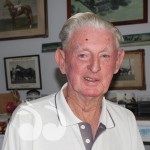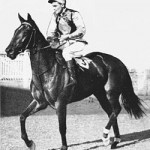The Greats of Yesteryear
By Harley Walden
OVER the years our great racehorses have brought racecourse crowds to their feet with their outstanding on course feats.
Today we will look at some of those greats of the past were they came from and what they achieved.
Flight became one of the most popular race mares in Sydney, with a remarkably consistent record of 24 wins and 28 placings in 65 starts between 1942 and 947.
Her record have been more impressive without the frustration of racing interruptions’ during the war.
She was second in the AJC Derby to Moorland, in the Metropolitan to Nightbeam and in the Sydney Cup to Craigie.
After the war in the 1945-1946 season she recorded eight wins and seven placing’s in 18 starts.
Her clash with Bernborough in the Chipping Norton Stakes attracted a large crowd to Randwick, she lost to him by a half head.
That season she also raced in Melbourne for the first time.
She won successive WS Cox Plates in 1945 and 1946.
Reared in NSW, she was retained for stud by her owner Brian Crowley (later Sir Brian, chairman of the AJC), and produced Flight’s Daughter, the dam of the brilliant performers Skyline and Sky High.
Vain, a chestnut horse by Wilkes from the good racemare Elated, was the greatest Australian sprinter since the Second World War despite an extremely short career.
In 14 starts he was beaten only twice which showed his merits.
Apart from the AJC Sires Produce Stakes where Beau Babylon beat him by three-quarters of a length, he won all the top two-year-old races by margins ranging from two lengths in the Debutant Stakes to four lengths in the Golden Slipper Stakes, eight in the Maribyrnong Stakes and 10 lengths in the Champagne Stakes at Randwick.
As a three-year-old he was outstated at his first attempt at a mile in the Moonee Valley Stakes by Daryl’s Joy (who later won the Cox Plate and the Victoria Derby), but beat that horse the following start in the Caulfield Stakes over the same distance.
At the Flemington spring carnival he won three major open sprints in the course of one week.
Carrying the top weight for his age in the Craven A Stakes he won by an amazing 12 lengths.
Five days later he toyed with his older opponents in the weight-for-age Linlithgow Stakes where he won by six lengths and broke the Flemington course record.
Finally, two days later he won the VRC’s richest mile, the Adams Handicap.
Bred in Victoria by the Johnson family, Vain was trained by Jim Maloney and ridden by Pat Hyland.
The horse was retired to Widden Stud where he became the leading Australian sire.
Kingston Town, by Bletchingly out of Ada Hunter was bred in Victoria by his owner, David Haines.
Offered unsuccessfully for sale as a yearling, he was sent to Sydney trainer Tommy Smith.
After failing at his first start he was gelded; thereafter he won 30 of 40 starts, including 11 in succession, and was unplaced on only three further occasions.
The first Australian horse to win $1 million in prizemoney, Kingston Town’s victories included the AJC Derby the Sydney Cup, and three Cox Plates.
He was beaten a short half-head by Gurner’s Lane in the 1982 Melbourne Cup.
Veno was the first acknowledged Australian (as against regional champion racehorses by virtue of his easy defeat of the Victorian mare Alice Hawthorne in an international match race over three miles at Flemington in1857.
The match race was set up when the owner of Alice Hawthorne, who had been unbeaten in her home state, challenged the best horse bred in NSW for £1,000-a side.
Bred in central NSW and described as a rich chestnut, he was by the Australian-bred Waverly and his dam was part Arab.
Like most horses of his era he was given time to develop: he was rising eight when after several wins in Sydney and country areas he was sold to G. W. Rowe.
He won 13 races that year. On four occasions he won two races in the one day.
This was the case at Flemington where he accounted for the fast Geelong horse Van Tromp over three miles on the same afternoon when he beat Alice Hawthorne.
The races attracted an unprecedented crowd, estimated at 40,000 at Flemington.
John Higgerson, the colony’s most notable jockey was the rider was the rider Etienne de Mestre chose to take to Melbourne to ride Veno in the famous 1857 match race against Alice Hawthorne.
Higgerson died in 1905, aged 95 at Heathcote on the outskirts of Sydney.
Wakeful, a champion racehorse and broodmare, was the best of many fine mares bred by William Wilson at St Albans Stud in Geelong Victoria.
On Wilson’s death in 1900 the unraced mare was sold to G.L. McDonald.
Under trainer H. Munro, she raced first as a four-year-old and after two starts in the spring she won three of the of the most important sprints on the calendar—the Oakleigh Plate, the Newmarket Handicap, and the AJC Doncaster—before running third in the two miles Sydney Cup.
This versatility remained a feature of her career: at five years of age her wins her wins ranged from one to three miles.
She lost the Caulfield Cup by a half-head, and won the Sydney Cup of 1902 carrying a record weight of 9st 7pounds (60.5kgs), in race record time.
As a six-year-old, and restricted chiefly to weight-for-age racing, she won 10 top class races at Randwick, Flemington and Caulfield.
In her final season as a seven-year-old, she won three races, including the VRC Melbourne Stakes for the third time, but her greatest performance was her last, in defeat, in the 1903 Melbourne Cup.
Her young jockey, Frank Dunn, carrying saddle-bags with lead to bring his weight to the allotted 10st (63.5kgs), miscalculated and had taken the mare to the front too far from home.
Wakeful remained in the lead until beaten in the last stride by the lightly weighted Lord Cardigan.
At stud she produced 10 foals, including the Oakleigh Plate and Futurity winner Blairgour, and Night Watch, who won the 1918 Melbourne Cup.
 scone.com.au
scone.com.au
